BUSN20016 Project Proposal: Technology and Business Performance
VerifiedAdded on 2023/06/11
|19
|3786
|296
Project
AI Summary
This project proposal investigates the impact of technology on various job-related parameters, including organizational performance, productivity, job satisfaction, and work-life balance. It includes a statement of the problem, research aims and objectives, a literature review discussing Innovation Diffusion Theory and the Theory of Reasoned Actions, and a methodology section outlining the use of secondary data analysis. The proposal also incorporates a Gantt chart for project scheduling and addresses the influence of technology on employee turnover and working relationships. The research aims to provide insights into the importance of adopting new technology systems and the risks associated with ignoring innovation in the business environment. Desklib offers a platform for students to access similar solved assignments and past papers.
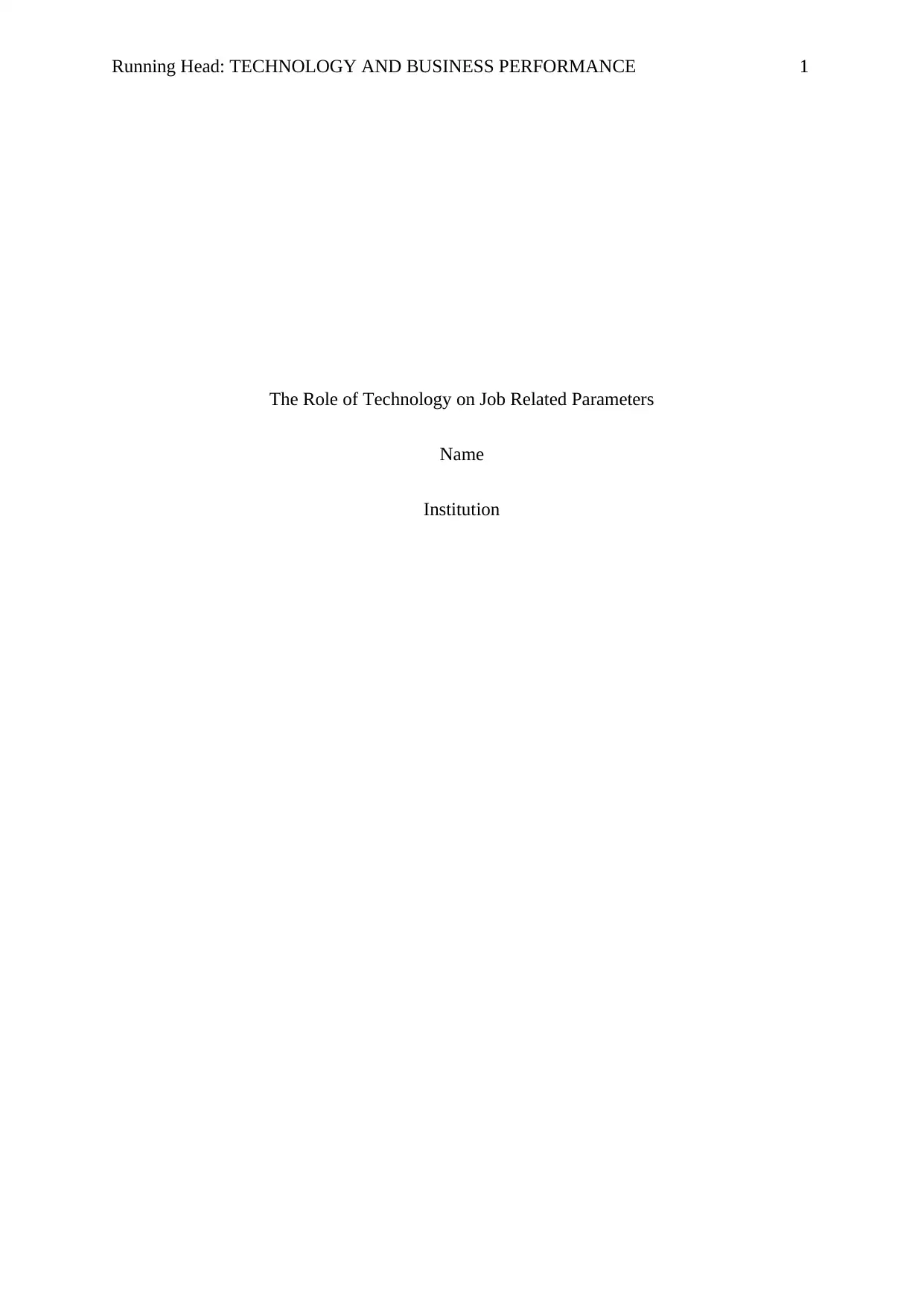
Running Head: TECHNOLOGY AND BUSINESS PERFORMANCE 1
The Role of Technology on Job Related Parameters
Name
Institution
The Role of Technology on Job Related Parameters
Name
Institution
Paraphrase This Document
Need a fresh take? Get an instant paraphrase of this document with our AI Paraphraser
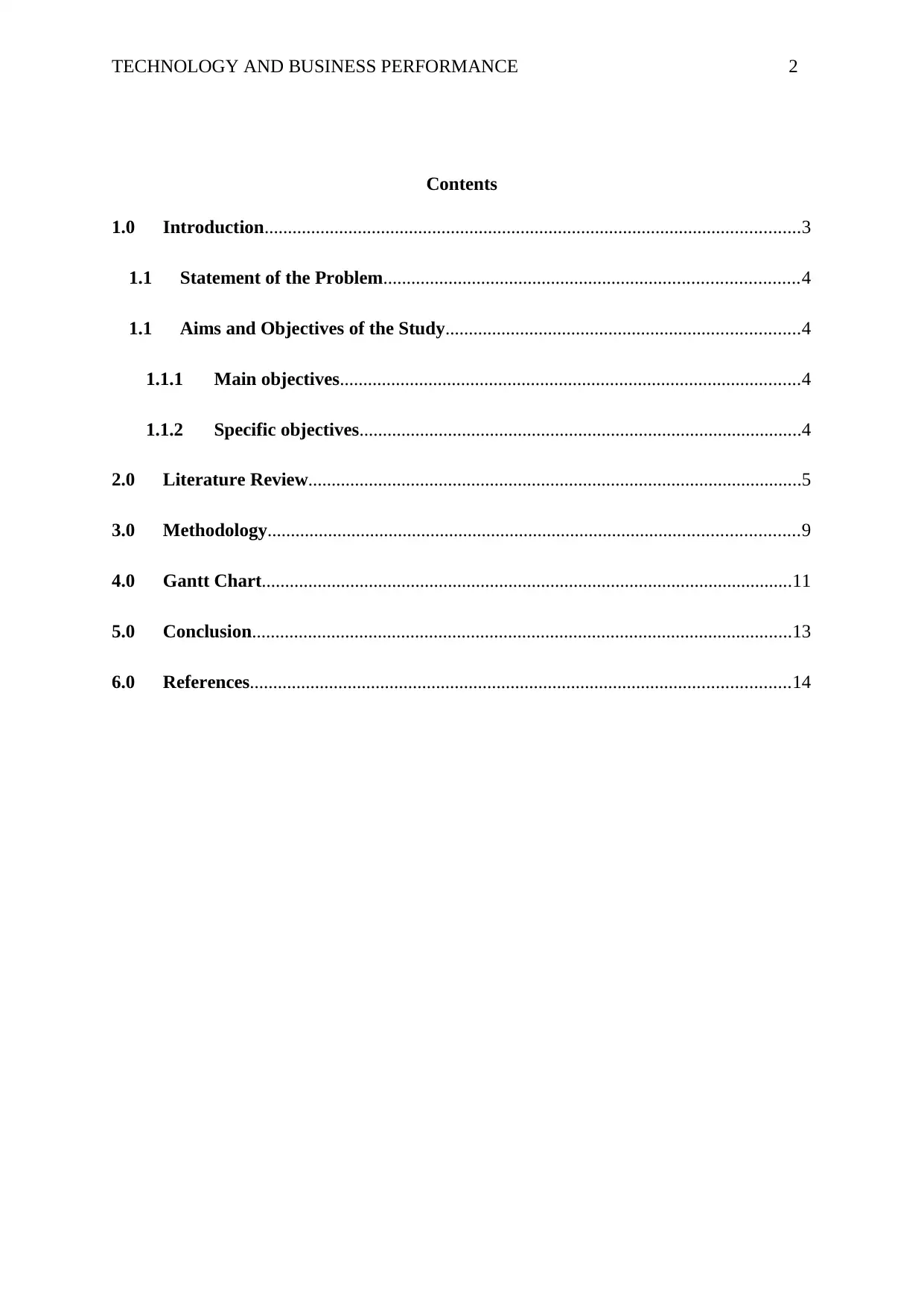
TECHNOLOGY AND BUSINESS PERFORMANCE 2
Contents
1.0 Introduction...................................................................................................................3
1.1 Statement of the Problem.........................................................................................4
1.1 Aims and Objectives of the Study............................................................................4
1.1.1 Main objectives...................................................................................................4
1.1.2 Specific objectives...............................................................................................4
2.0 Literature Review..........................................................................................................5
3.0 Methodology..................................................................................................................9
4.0 Gantt Chart..................................................................................................................11
5.0 Conclusion....................................................................................................................13
6.0 References....................................................................................................................14
Contents
1.0 Introduction...................................................................................................................3
1.1 Statement of the Problem.........................................................................................4
1.1 Aims and Objectives of the Study............................................................................4
1.1.1 Main objectives...................................................................................................4
1.1.2 Specific objectives...............................................................................................4
2.0 Literature Review..........................................................................................................5
3.0 Methodology..................................................................................................................9
4.0 Gantt Chart..................................................................................................................11
5.0 Conclusion....................................................................................................................13
6.0 References....................................................................................................................14
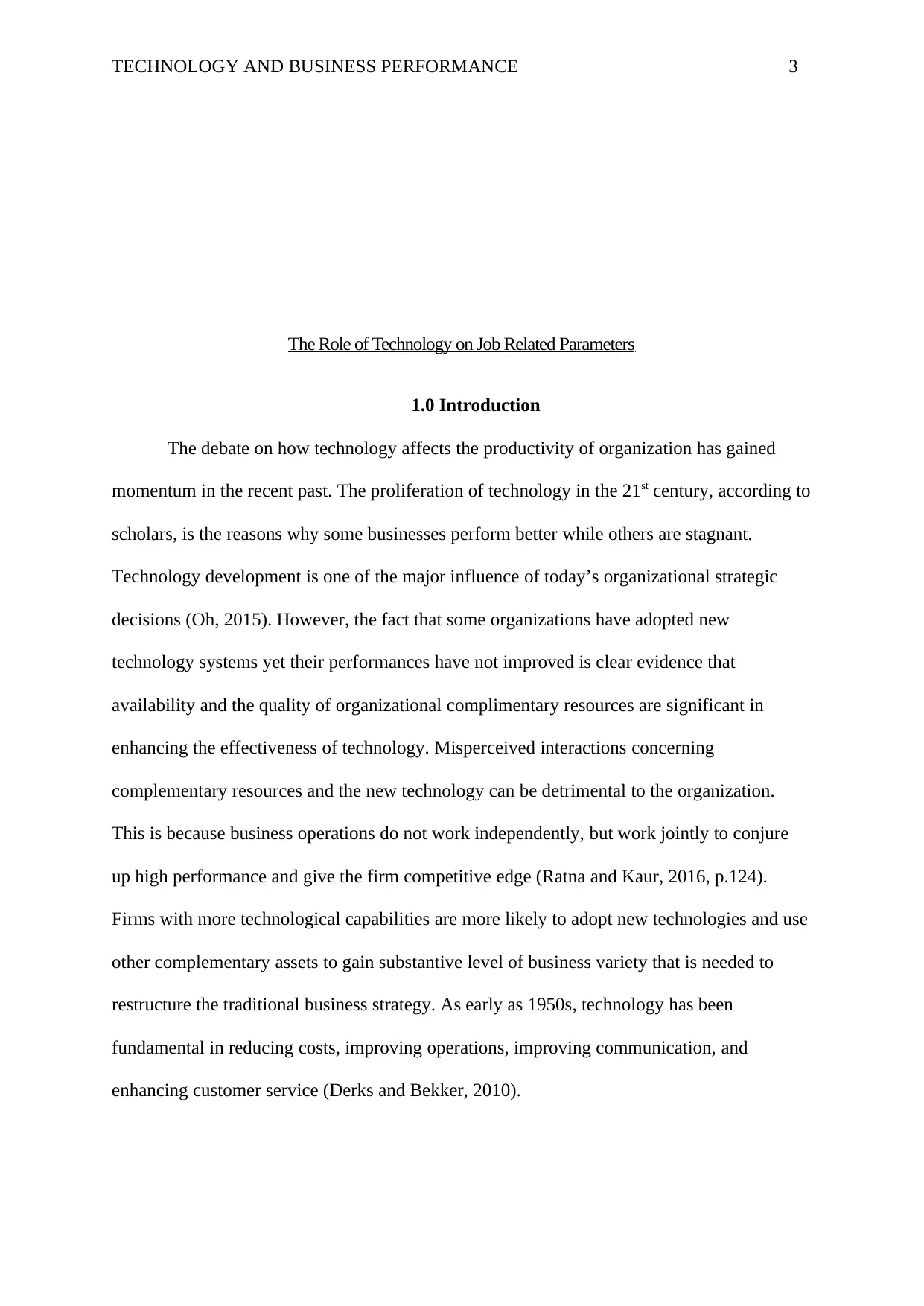
TECHNOLOGY AND BUSINESS PERFORMANCE 3
The Role of Technology on Job Related Parameters
1.0 Introduction
The debate on how technology affects the productivity of organization has gained
momentum in the recent past. The proliferation of technology in the 21st century, according to
scholars, is the reasons why some businesses perform better while others are stagnant.
Technology development is one of the major influence of today’s organizational strategic
decisions (Oh, 2015). However, the fact that some organizations have adopted new
technology systems yet their performances have not improved is clear evidence that
availability and the quality of organizational complimentary resources are significant in
enhancing the effectiveness of technology. Misperceived interactions concerning
complementary resources and the new technology can be detrimental to the organization.
This is because business operations do not work independently, but work jointly to conjure
up high performance and give the firm competitive edge (Ratna and Kaur, 2016, p.124).
Firms with more technological capabilities are more likely to adopt new technologies and use
other complementary assets to gain substantive level of business variety that is needed to
restructure the traditional business strategy. As early as 1950s, technology has been
fundamental in reducing costs, improving operations, improving communication, and
enhancing customer service (Derks and Bekker, 2010).
The Role of Technology on Job Related Parameters
1.0 Introduction
The debate on how technology affects the productivity of organization has gained
momentum in the recent past. The proliferation of technology in the 21st century, according to
scholars, is the reasons why some businesses perform better while others are stagnant.
Technology development is one of the major influence of today’s organizational strategic
decisions (Oh, 2015). However, the fact that some organizations have adopted new
technology systems yet their performances have not improved is clear evidence that
availability and the quality of organizational complimentary resources are significant in
enhancing the effectiveness of technology. Misperceived interactions concerning
complementary resources and the new technology can be detrimental to the organization.
This is because business operations do not work independently, but work jointly to conjure
up high performance and give the firm competitive edge (Ratna and Kaur, 2016, p.124).
Firms with more technological capabilities are more likely to adopt new technologies and use
other complementary assets to gain substantive level of business variety that is needed to
restructure the traditional business strategy. As early as 1950s, technology has been
fundamental in reducing costs, improving operations, improving communication, and
enhancing customer service (Derks and Bekker, 2010).
⊘ This is a preview!⊘
Do you want full access?
Subscribe today to unlock all pages.

Trusted by 1+ million students worldwide
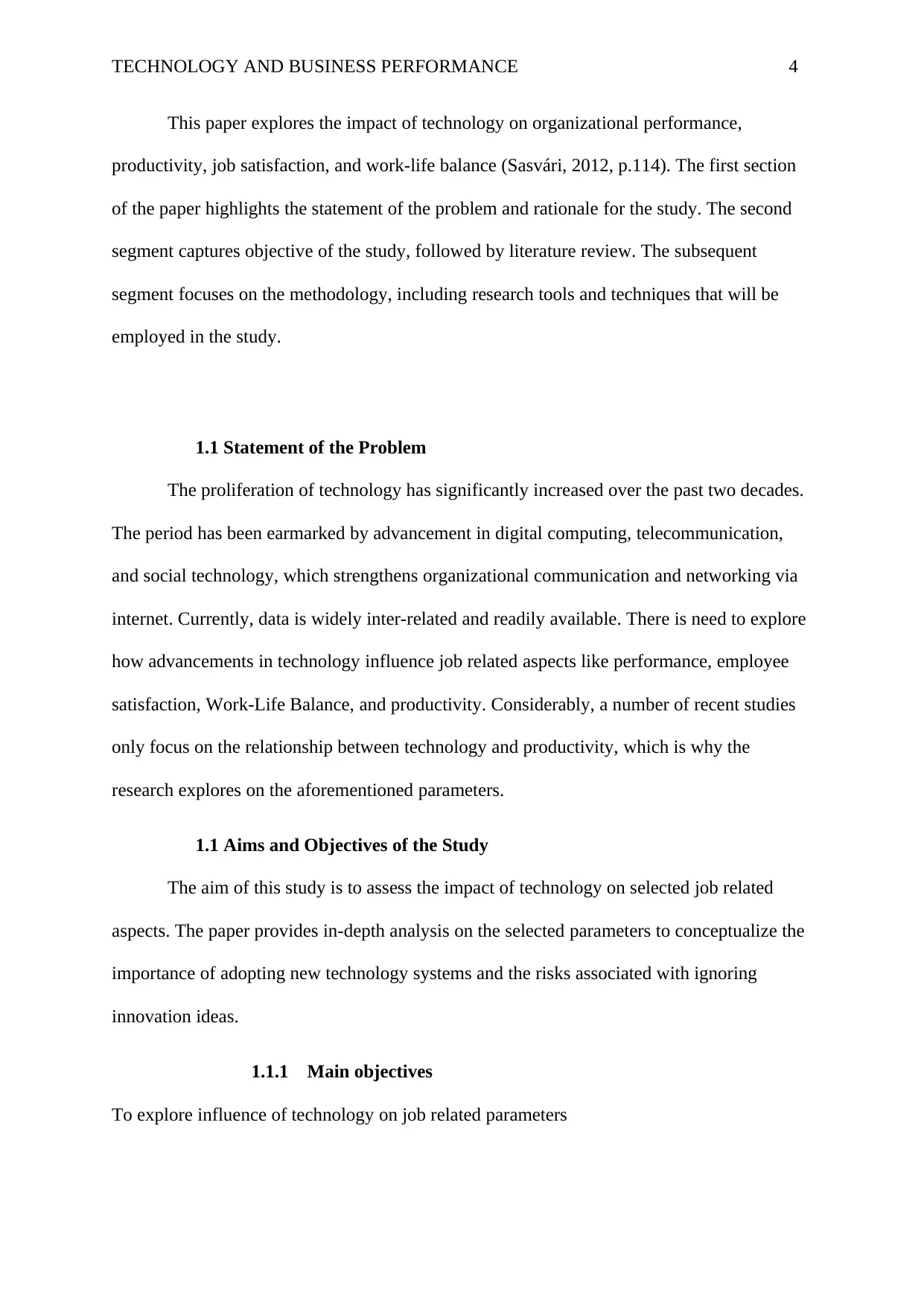
TECHNOLOGY AND BUSINESS PERFORMANCE 4
This paper explores the impact of technology on organizational performance,
productivity, job satisfaction, and work-life balance (Sasvári, 2012, p.114). The first section
of the paper highlights the statement of the problem and rationale for the study. The second
segment captures objective of the study, followed by literature review. The subsequent
segment focuses on the methodology, including research tools and techniques that will be
employed in the study.
1.1 Statement of the Problem
The proliferation of technology has significantly increased over the past two decades.
The period has been earmarked by advancement in digital computing, telecommunication,
and social technology, which strengthens organizational communication and networking via
internet. Currently, data is widely inter-related and readily available. There is need to explore
how advancements in technology influence job related aspects like performance, employee
satisfaction, Work-Life Balance, and productivity. Considerably, a number of recent studies
only focus on the relationship between technology and productivity, which is why the
research explores on the aforementioned parameters.
1.1 Aims and Objectives of the Study
The aim of this study is to assess the impact of technology on selected job related
aspects. The paper provides in-depth analysis on the selected parameters to conceptualize the
importance of adopting new technology systems and the risks associated with ignoring
innovation ideas.
1.1.1 Main objectives
To explore influence of technology on job related parameters
This paper explores the impact of technology on organizational performance,
productivity, job satisfaction, and work-life balance (Sasvári, 2012, p.114). The first section
of the paper highlights the statement of the problem and rationale for the study. The second
segment captures objective of the study, followed by literature review. The subsequent
segment focuses on the methodology, including research tools and techniques that will be
employed in the study.
1.1 Statement of the Problem
The proliferation of technology has significantly increased over the past two decades.
The period has been earmarked by advancement in digital computing, telecommunication,
and social technology, which strengthens organizational communication and networking via
internet. Currently, data is widely inter-related and readily available. There is need to explore
how advancements in technology influence job related aspects like performance, employee
satisfaction, Work-Life Balance, and productivity. Considerably, a number of recent studies
only focus on the relationship between technology and productivity, which is why the
research explores on the aforementioned parameters.
1.1 Aims and Objectives of the Study
The aim of this study is to assess the impact of technology on selected job related
aspects. The paper provides in-depth analysis on the selected parameters to conceptualize the
importance of adopting new technology systems and the risks associated with ignoring
innovation ideas.
1.1.1 Main objectives
To explore influence of technology on job related parameters
Paraphrase This Document
Need a fresh take? Get an instant paraphrase of this document with our AI Paraphraser
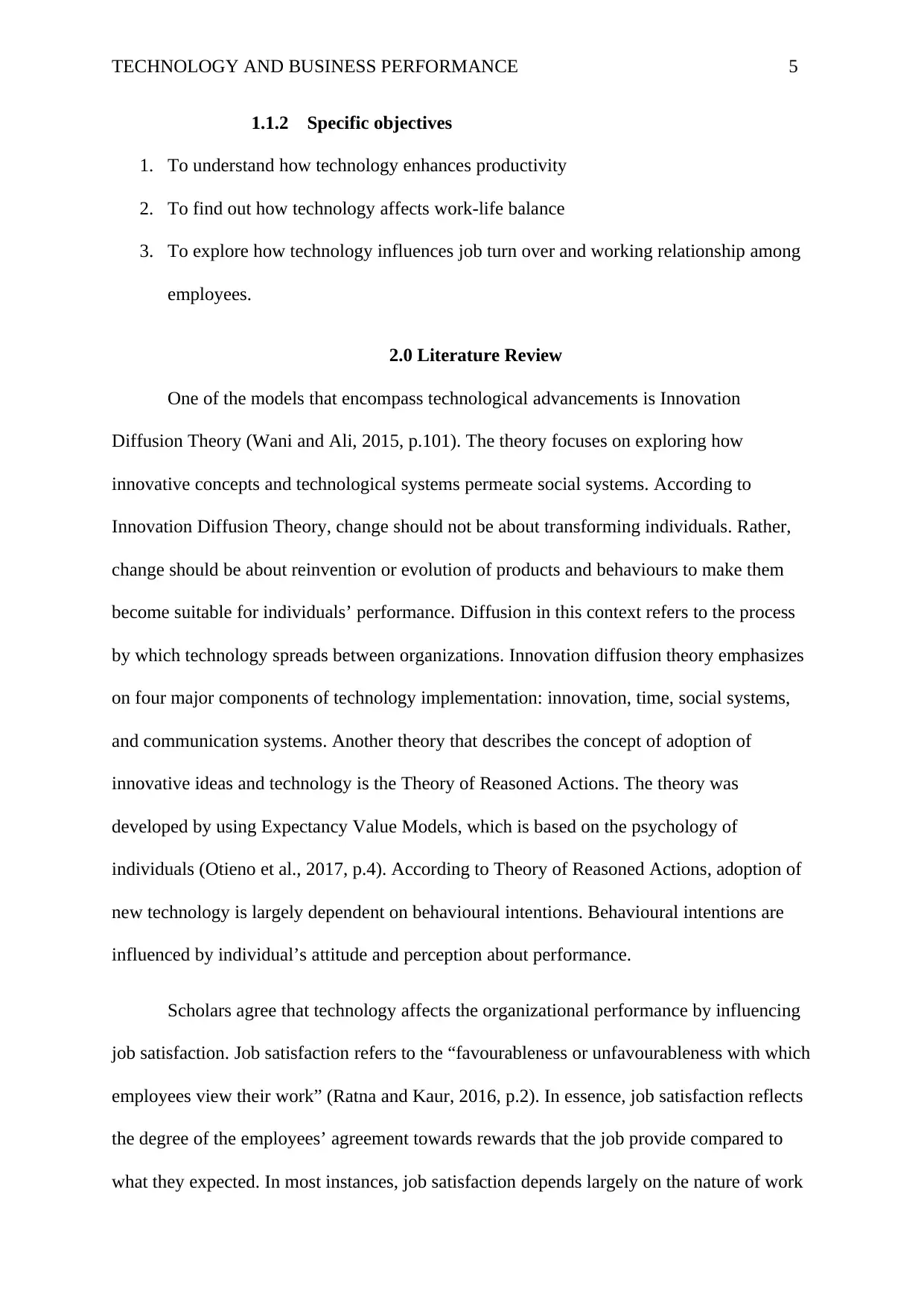
TECHNOLOGY AND BUSINESS PERFORMANCE 5
1.1.2 Specific objectives
1. To understand how technology enhances productivity
2. To find out how technology affects work-life balance
3. To explore how technology influences job turn over and working relationship among
employees.
2.0 Literature Review
One of the models that encompass technological advancements is Innovation
Diffusion Theory (Wani and Ali, 2015, p.101). The theory focuses on exploring how
innovative concepts and technological systems permeate social systems. According to
Innovation Diffusion Theory, change should not be about transforming individuals. Rather,
change should be about reinvention or evolution of products and behaviours to make them
become suitable for individuals’ performance. Diffusion in this context refers to the process
by which technology spreads between organizations. Innovation diffusion theory emphasizes
on four major components of technology implementation: innovation, time, social systems,
and communication systems. Another theory that describes the concept of adoption of
innovative ideas and technology is the Theory of Reasoned Actions. The theory was
developed by using Expectancy Value Models, which is based on the psychology of
individuals (Otieno et al., 2017, p.4). According to Theory of Reasoned Actions, adoption of
new technology is largely dependent on behavioural intentions. Behavioural intentions are
influenced by individual’s attitude and perception about performance.
Scholars agree that technology affects the organizational performance by influencing
job satisfaction. Job satisfaction refers to the “favourableness or unfavourableness with which
employees view their work” (Ratna and Kaur, 2016, p.2). In essence, job satisfaction reflects
the degree of the employees’ agreement towards rewards that the job provide compared to
what they expected. In most instances, job satisfaction depends largely on the nature of work
1.1.2 Specific objectives
1. To understand how technology enhances productivity
2. To find out how technology affects work-life balance
3. To explore how technology influences job turn over and working relationship among
employees.
2.0 Literature Review
One of the models that encompass technological advancements is Innovation
Diffusion Theory (Wani and Ali, 2015, p.101). The theory focuses on exploring how
innovative concepts and technological systems permeate social systems. According to
Innovation Diffusion Theory, change should not be about transforming individuals. Rather,
change should be about reinvention or evolution of products and behaviours to make them
become suitable for individuals’ performance. Diffusion in this context refers to the process
by which technology spreads between organizations. Innovation diffusion theory emphasizes
on four major components of technology implementation: innovation, time, social systems,
and communication systems. Another theory that describes the concept of adoption of
innovative ideas and technology is the Theory of Reasoned Actions. The theory was
developed by using Expectancy Value Models, which is based on the psychology of
individuals (Otieno et al., 2017, p.4). According to Theory of Reasoned Actions, adoption of
new technology is largely dependent on behavioural intentions. Behavioural intentions are
influenced by individual’s attitude and perception about performance.
Scholars agree that technology affects the organizational performance by influencing
job satisfaction. Job satisfaction refers to the “favourableness or unfavourableness with which
employees view their work” (Ratna and Kaur, 2016, p.2). In essence, job satisfaction reflects
the degree of the employees’ agreement towards rewards that the job provide compared to
what they expected. In most instances, job satisfaction depends largely on the nature of work
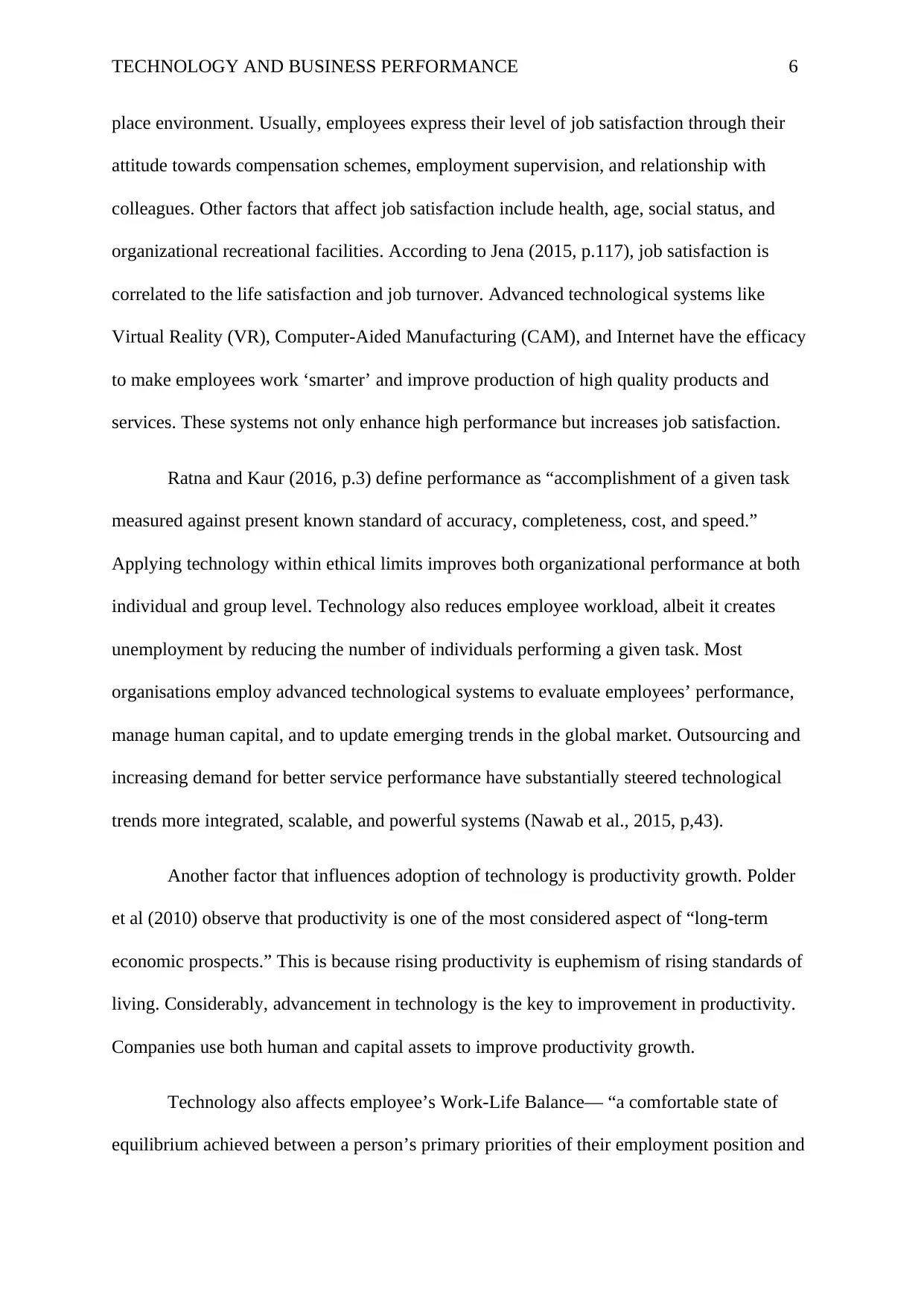
TECHNOLOGY AND BUSINESS PERFORMANCE 6
place environment. Usually, employees express their level of job satisfaction through their
attitude towards compensation schemes, employment supervision, and relationship with
colleagues. Other factors that affect job satisfaction include health, age, social status, and
organizational recreational facilities. According to Jena (2015, p.117), job satisfaction is
correlated to the life satisfaction and job turnover. Advanced technological systems like
Virtual Reality (VR), Computer-Aided Manufacturing (CAM), and Internet have the efficacy
to make employees work ‘smarter’ and improve production of high quality products and
services. These systems not only enhance high performance but increases job satisfaction.
Ratna and Kaur (2016, p.3) define performance as “accomplishment of a given task
measured against present known standard of accuracy, completeness, cost, and speed.”
Applying technology within ethical limits improves both organizational performance at both
individual and group level. Technology also reduces employee workload, albeit it creates
unemployment by reducing the number of individuals performing a given task. Most
organisations employ advanced technological systems to evaluate employees’ performance,
manage human capital, and to update emerging trends in the global market. Outsourcing and
increasing demand for better service performance have substantially steered technological
trends more integrated, scalable, and powerful systems (Nawab et al., 2015, p,43).
Another factor that influences adoption of technology is productivity growth. Polder
et al (2010) observe that productivity is one of the most considered aspect of “long-term
economic prospects.” This is because rising productivity is euphemism of rising standards of
living. Considerably, advancement in technology is the key to improvement in productivity.
Companies use both human and capital assets to improve productivity growth.
Technology also affects employee’s Work-Life Balance— “a comfortable state of
equilibrium achieved between a person’s primary priorities of their employment position and
place environment. Usually, employees express their level of job satisfaction through their
attitude towards compensation schemes, employment supervision, and relationship with
colleagues. Other factors that affect job satisfaction include health, age, social status, and
organizational recreational facilities. According to Jena (2015, p.117), job satisfaction is
correlated to the life satisfaction and job turnover. Advanced technological systems like
Virtual Reality (VR), Computer-Aided Manufacturing (CAM), and Internet have the efficacy
to make employees work ‘smarter’ and improve production of high quality products and
services. These systems not only enhance high performance but increases job satisfaction.
Ratna and Kaur (2016, p.3) define performance as “accomplishment of a given task
measured against present known standard of accuracy, completeness, cost, and speed.”
Applying technology within ethical limits improves both organizational performance at both
individual and group level. Technology also reduces employee workload, albeit it creates
unemployment by reducing the number of individuals performing a given task. Most
organisations employ advanced technological systems to evaluate employees’ performance,
manage human capital, and to update emerging trends in the global market. Outsourcing and
increasing demand for better service performance have substantially steered technological
trends more integrated, scalable, and powerful systems (Nawab et al., 2015, p,43).
Another factor that influences adoption of technology is productivity growth. Polder
et al (2010) observe that productivity is one of the most considered aspect of “long-term
economic prospects.” This is because rising productivity is euphemism of rising standards of
living. Considerably, advancement in technology is the key to improvement in productivity.
Companies use both human and capital assets to improve productivity growth.
Technology also affects employee’s Work-Life Balance— “a comfortable state of
equilibrium achieved between a person’s primary priorities of their employment position and
⊘ This is a preview!⊘
Do you want full access?
Subscribe today to unlock all pages.

Trusted by 1+ million students worldwide
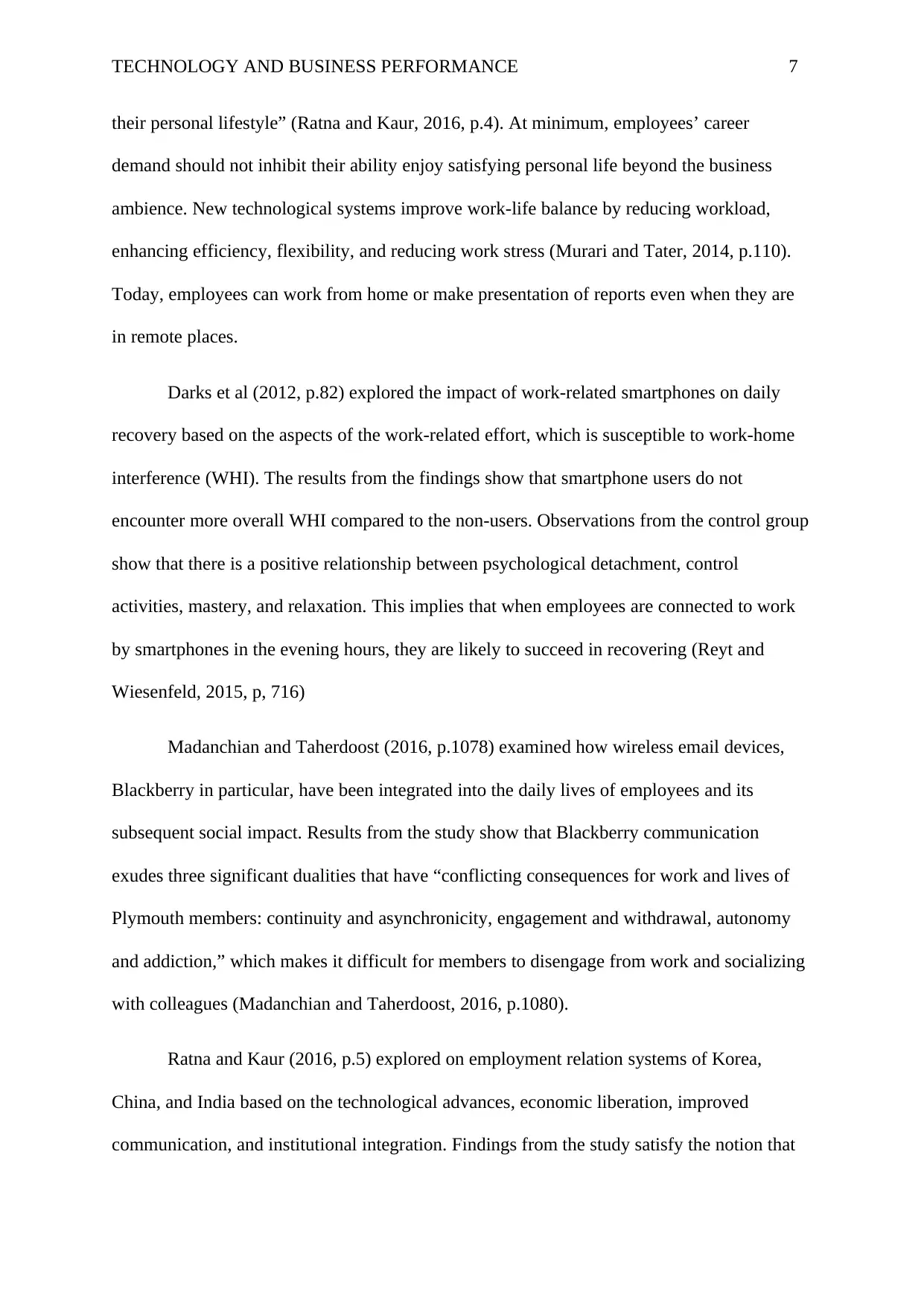
TECHNOLOGY AND BUSINESS PERFORMANCE 7
their personal lifestyle” (Ratna and Kaur, 2016, p.4). At minimum, employees’ career
demand should not inhibit their ability enjoy satisfying personal life beyond the business
ambience. New technological systems improve work-life balance by reducing workload,
enhancing efficiency, flexibility, and reducing work stress (Murari and Tater, 2014, p.110).
Today, employees can work from home or make presentation of reports even when they are
in remote places.
Darks et al (2012, p.82) explored the impact of work-related smartphones on daily
recovery based on the aspects of the work-related effort, which is susceptible to work-home
interference (WHI). The results from the findings show that smartphone users do not
encounter more overall WHI compared to the non-users. Observations from the control group
show that there is a positive relationship between psychological detachment, control
activities, mastery, and relaxation. This implies that when employees are connected to work
by smartphones in the evening hours, they are likely to succeed in recovering (Reyt and
Wiesenfeld, 2015, p, 716)
Madanchian and Taherdoost (2016, p.1078) examined how wireless email devices,
Blackberry in particular, have been integrated into the daily lives of employees and its
subsequent social impact. Results from the study show that Blackberry communication
exudes three significant dualities that have “conflicting consequences for work and lives of
Plymouth members: continuity and asynchronicity, engagement and withdrawal, autonomy
and addiction,” which makes it difficult for members to disengage from work and socializing
with colleagues (Madanchian and Taherdoost, 2016, p.1080).
Ratna and Kaur (2016, p.5) explored on employment relation systems of Korea,
China, and India based on the technological advances, economic liberation, improved
communication, and institutional integration. Findings from the study satisfy the notion that
their personal lifestyle” (Ratna and Kaur, 2016, p.4). At minimum, employees’ career
demand should not inhibit their ability enjoy satisfying personal life beyond the business
ambience. New technological systems improve work-life balance by reducing workload,
enhancing efficiency, flexibility, and reducing work stress (Murari and Tater, 2014, p.110).
Today, employees can work from home or make presentation of reports even when they are
in remote places.
Darks et al (2012, p.82) explored the impact of work-related smartphones on daily
recovery based on the aspects of the work-related effort, which is susceptible to work-home
interference (WHI). The results from the findings show that smartphone users do not
encounter more overall WHI compared to the non-users. Observations from the control group
show that there is a positive relationship between psychological detachment, control
activities, mastery, and relaxation. This implies that when employees are connected to work
by smartphones in the evening hours, they are likely to succeed in recovering (Reyt and
Wiesenfeld, 2015, p, 716)
Madanchian and Taherdoost (2016, p.1078) examined how wireless email devices,
Blackberry in particular, have been integrated into the daily lives of employees and its
subsequent social impact. Results from the study show that Blackberry communication
exudes three significant dualities that have “conflicting consequences for work and lives of
Plymouth members: continuity and asynchronicity, engagement and withdrawal, autonomy
and addiction,” which makes it difficult for members to disengage from work and socializing
with colleagues (Madanchian and Taherdoost, 2016, p.1080).
Ratna and Kaur (2016, p.5) explored on employment relation systems of Korea,
China, and India based on the technological advances, economic liberation, improved
communication, and institutional integration. Findings from the study satisfy the notion that
Paraphrase This Document
Need a fresh take? Get an instant paraphrase of this document with our AI Paraphraser
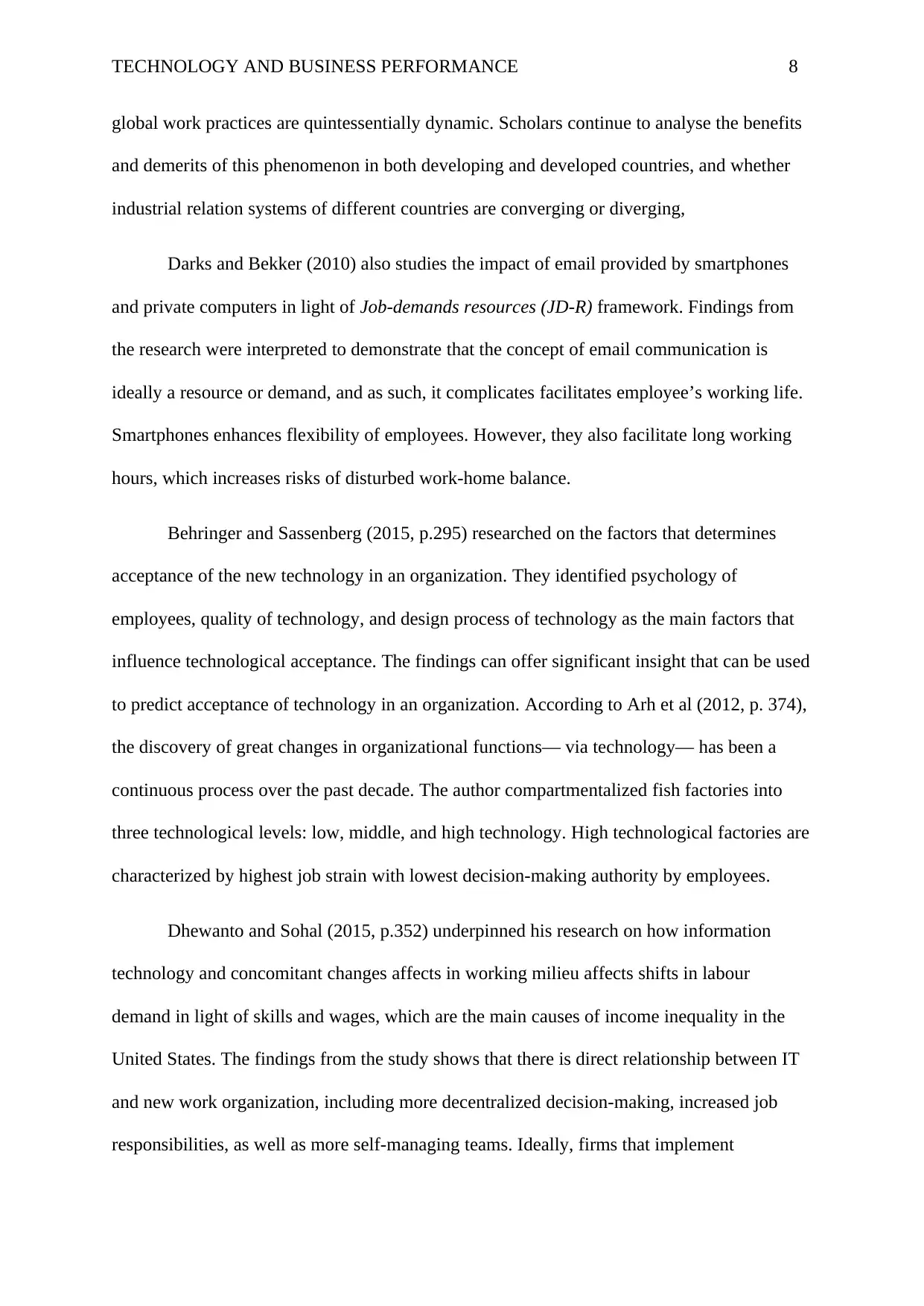
TECHNOLOGY AND BUSINESS PERFORMANCE 8
global work practices are quintessentially dynamic. Scholars continue to analyse the benefits
and demerits of this phenomenon in both developing and developed countries, and whether
industrial relation systems of different countries are converging or diverging,
Darks and Bekker (2010) also studies the impact of email provided by smartphones
and private computers in light of Job-demands resources (JD-R) framework. Findings from
the research were interpreted to demonstrate that the concept of email communication is
ideally a resource or demand, and as such, it complicates facilitates employee’s working life.
Smartphones enhances flexibility of employees. However, they also facilitate long working
hours, which increases risks of disturbed work-home balance.
Behringer and Sassenberg (2015, p.295) researched on the factors that determines
acceptance of the new technology in an organization. They identified psychology of
employees, quality of technology, and design process of technology as the main factors that
influence technological acceptance. The findings can offer significant insight that can be used
to predict acceptance of technology in an organization. According to Arh et al (2012, p. 374),
the discovery of great changes in organizational functions— via technology— has been a
continuous process over the past decade. The author compartmentalized fish factories into
three technological levels: low, middle, and high technology. High technological factories are
characterized by highest job strain with lowest decision-making authority by employees.
Dhewanto and Sohal (2015, p.352) underpinned his research on how information
technology and concomitant changes affects in working milieu affects shifts in labour
demand in light of skills and wages, which are the main causes of income inequality in the
United States. The findings from the study shows that there is direct relationship between IT
and new work organization, including more decentralized decision-making, increased job
responsibilities, as well as more self-managing teams. Ideally, firms that implement
global work practices are quintessentially dynamic. Scholars continue to analyse the benefits
and demerits of this phenomenon in both developing and developed countries, and whether
industrial relation systems of different countries are converging or diverging,
Darks and Bekker (2010) also studies the impact of email provided by smartphones
and private computers in light of Job-demands resources (JD-R) framework. Findings from
the research were interpreted to demonstrate that the concept of email communication is
ideally a resource or demand, and as such, it complicates facilitates employee’s working life.
Smartphones enhances flexibility of employees. However, they also facilitate long working
hours, which increases risks of disturbed work-home balance.
Behringer and Sassenberg (2015, p.295) researched on the factors that determines
acceptance of the new technology in an organization. They identified psychology of
employees, quality of technology, and design process of technology as the main factors that
influence technological acceptance. The findings can offer significant insight that can be used
to predict acceptance of technology in an organization. According to Arh et al (2012, p. 374),
the discovery of great changes in organizational functions— via technology— has been a
continuous process over the past decade. The author compartmentalized fish factories into
three technological levels: low, middle, and high technology. High technological factories are
characterized by highest job strain with lowest decision-making authority by employees.
Dhewanto and Sohal (2015, p.352) underpinned his research on how information
technology and concomitant changes affects in working milieu affects shifts in labour
demand in light of skills and wages, which are the main causes of income inequality in the
United States. The findings from the study shows that there is direct relationship between IT
and new work organization, including more decentralized decision-making, increased job
responsibilities, as well as more self-managing teams. Ideally, firms that implement
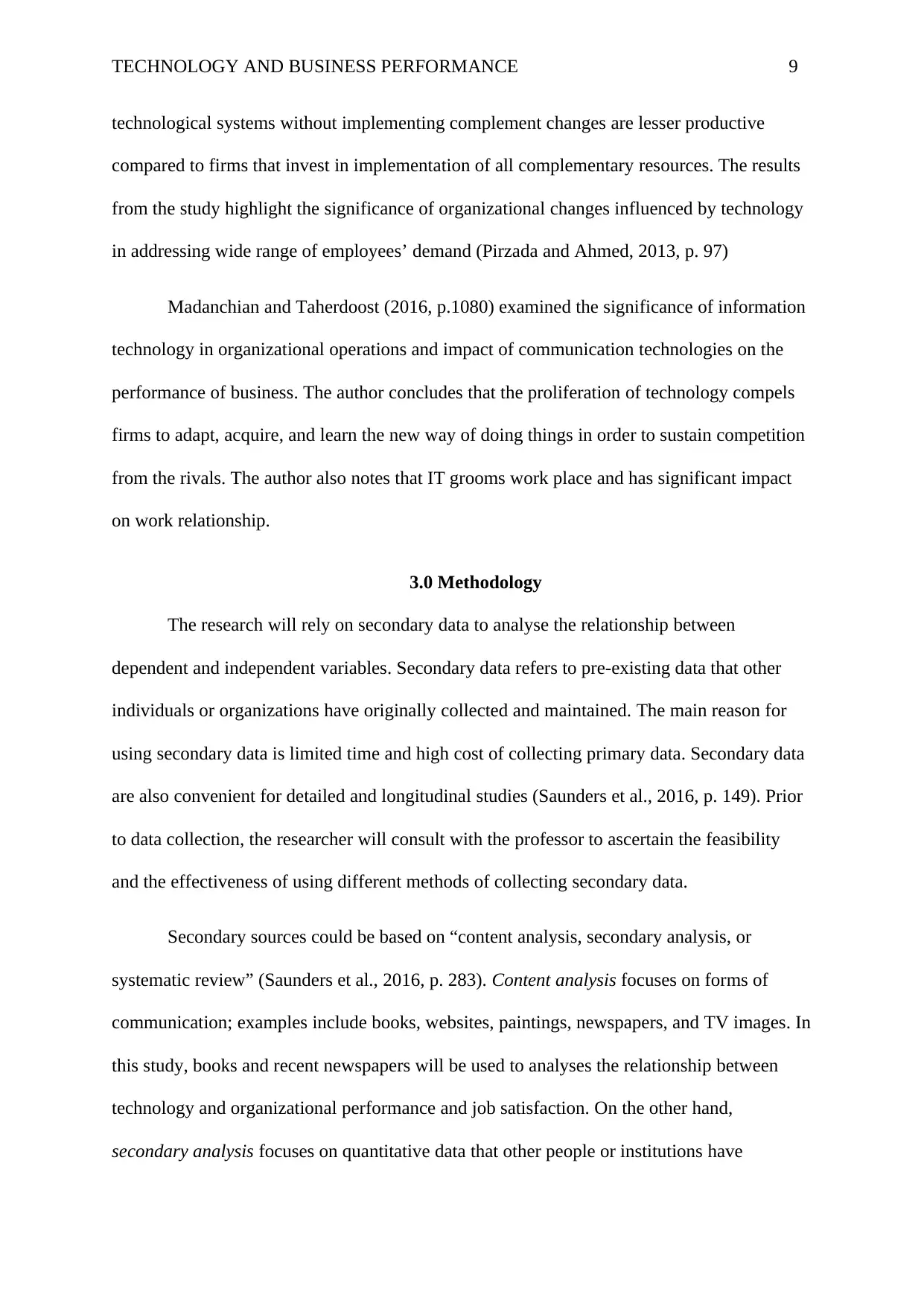
TECHNOLOGY AND BUSINESS PERFORMANCE 9
technological systems without implementing complement changes are lesser productive
compared to firms that invest in implementation of all complementary resources. The results
from the study highlight the significance of organizational changes influenced by technology
in addressing wide range of employees’ demand (Pirzada and Ahmed, 2013, p. 97)
Madanchian and Taherdoost (2016, p.1080) examined the significance of information
technology in organizational operations and impact of communication technologies on the
performance of business. The author concludes that the proliferation of technology compels
firms to adapt, acquire, and learn the new way of doing things in order to sustain competition
from the rivals. The author also notes that IT grooms work place and has significant impact
on work relationship.
3.0 Methodology
The research will rely on secondary data to analyse the relationship between
dependent and independent variables. Secondary data refers to pre-existing data that other
individuals or organizations have originally collected and maintained. The main reason for
using secondary data is limited time and high cost of collecting primary data. Secondary data
are also convenient for detailed and longitudinal studies (Saunders et al., 2016, p. 149). Prior
to data collection, the researcher will consult with the professor to ascertain the feasibility
and the effectiveness of using different methods of collecting secondary data.
Secondary sources could be based on “content analysis, secondary analysis, or
systematic review” (Saunders et al., 2016, p. 283). Content analysis focuses on forms of
communication; examples include books, websites, paintings, newspapers, and TV images. In
this study, books and recent newspapers will be used to analyses the relationship between
technology and organizational performance and job satisfaction. On the other hand,
secondary analysis focuses on quantitative data that other people or institutions have
technological systems without implementing complement changes are lesser productive
compared to firms that invest in implementation of all complementary resources. The results
from the study highlight the significance of organizational changes influenced by technology
in addressing wide range of employees’ demand (Pirzada and Ahmed, 2013, p. 97)
Madanchian and Taherdoost (2016, p.1080) examined the significance of information
technology in organizational operations and impact of communication technologies on the
performance of business. The author concludes that the proliferation of technology compels
firms to adapt, acquire, and learn the new way of doing things in order to sustain competition
from the rivals. The author also notes that IT grooms work place and has significant impact
on work relationship.
3.0 Methodology
The research will rely on secondary data to analyse the relationship between
dependent and independent variables. Secondary data refers to pre-existing data that other
individuals or organizations have originally collected and maintained. The main reason for
using secondary data is limited time and high cost of collecting primary data. Secondary data
are also convenient for detailed and longitudinal studies (Saunders et al., 2016, p. 149). Prior
to data collection, the researcher will consult with the professor to ascertain the feasibility
and the effectiveness of using different methods of collecting secondary data.
Secondary sources could be based on “content analysis, secondary analysis, or
systematic review” (Saunders et al., 2016, p. 283). Content analysis focuses on forms of
communication; examples include books, websites, paintings, newspapers, and TV images. In
this study, books and recent newspapers will be used to analyses the relationship between
technology and organizational performance and job satisfaction. On the other hand,
secondary analysis focuses on quantitative data that other people or institutions have
⊘ This is a preview!⊘
Do you want full access?
Subscribe today to unlock all pages.

Trusted by 1+ million students worldwide
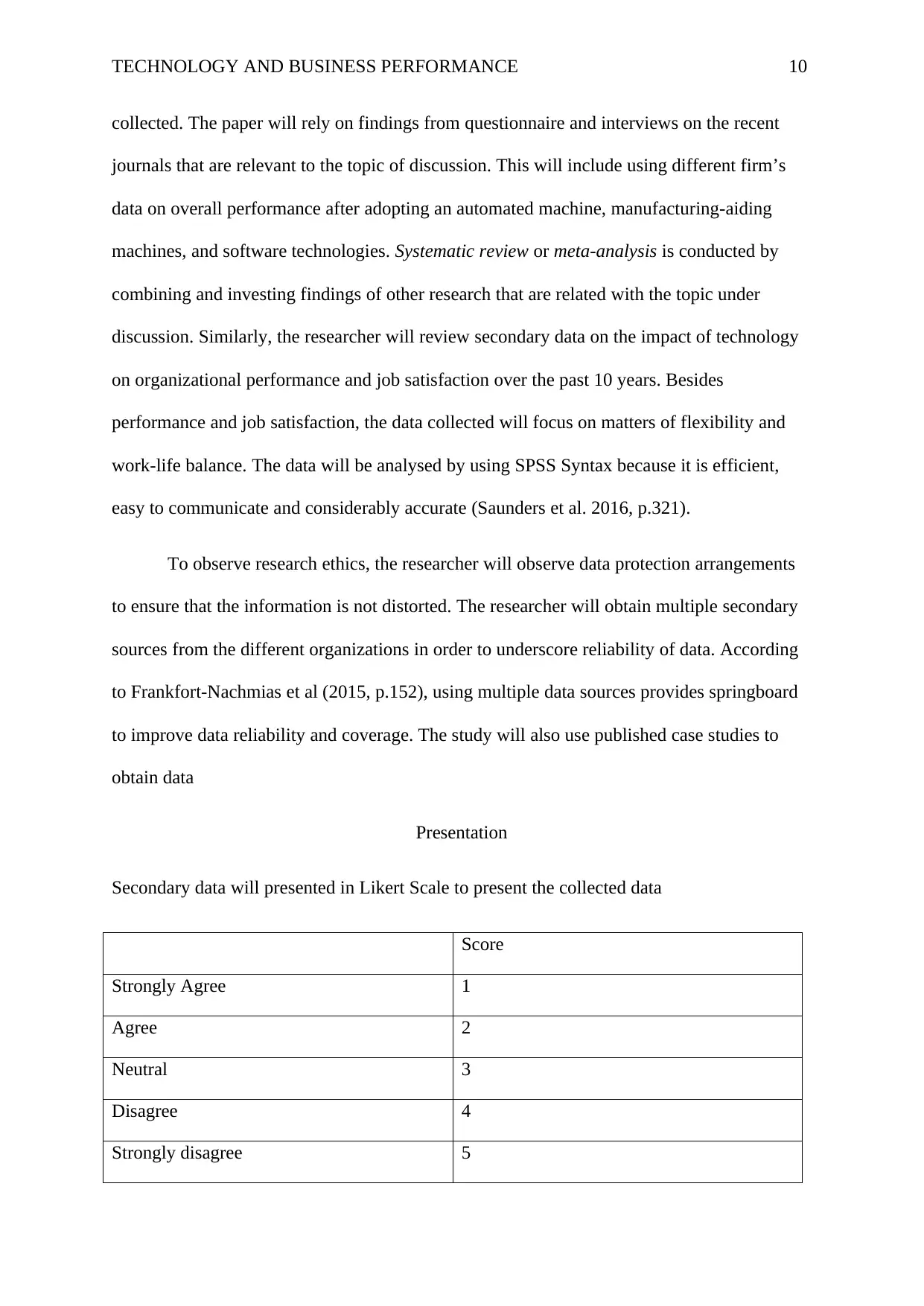
TECHNOLOGY AND BUSINESS PERFORMANCE 10
collected. The paper will rely on findings from questionnaire and interviews on the recent
journals that are relevant to the topic of discussion. This will include using different firm’s
data on overall performance after adopting an automated machine, manufacturing-aiding
machines, and software technologies. Systematic review or meta-analysis is conducted by
combining and investing findings of other research that are related with the topic under
discussion. Similarly, the researcher will review secondary data on the impact of technology
on organizational performance and job satisfaction over the past 10 years. Besides
performance and job satisfaction, the data collected will focus on matters of flexibility and
work-life balance. The data will be analysed by using SPSS Syntax because it is efficient,
easy to communicate and considerably accurate (Saunders et al. 2016, p.321).
To observe research ethics, the researcher will observe data protection arrangements
to ensure that the information is not distorted. The researcher will obtain multiple secondary
sources from the different organizations in order to underscore reliability of data. According
to Frankfort-Nachmias et al (2015, p.152), using multiple data sources provides springboard
to improve data reliability and coverage. The study will also use published case studies to
obtain data
Presentation
Secondary data will presented in Likert Scale to present the collected data
Score
Strongly Agree 1
Agree 2
Neutral 3
Disagree 4
Strongly disagree 5
collected. The paper will rely on findings from questionnaire and interviews on the recent
journals that are relevant to the topic of discussion. This will include using different firm’s
data on overall performance after adopting an automated machine, manufacturing-aiding
machines, and software technologies. Systematic review or meta-analysis is conducted by
combining and investing findings of other research that are related with the topic under
discussion. Similarly, the researcher will review secondary data on the impact of technology
on organizational performance and job satisfaction over the past 10 years. Besides
performance and job satisfaction, the data collected will focus on matters of flexibility and
work-life balance. The data will be analysed by using SPSS Syntax because it is efficient,
easy to communicate and considerably accurate (Saunders et al. 2016, p.321).
To observe research ethics, the researcher will observe data protection arrangements
to ensure that the information is not distorted. The researcher will obtain multiple secondary
sources from the different organizations in order to underscore reliability of data. According
to Frankfort-Nachmias et al (2015, p.152), using multiple data sources provides springboard
to improve data reliability and coverage. The study will also use published case studies to
obtain data
Presentation
Secondary data will presented in Likert Scale to present the collected data
Score
Strongly Agree 1
Agree 2
Neutral 3
Disagree 4
Strongly disagree 5
Paraphrase This Document
Need a fresh take? Get an instant paraphrase of this document with our AI Paraphraser
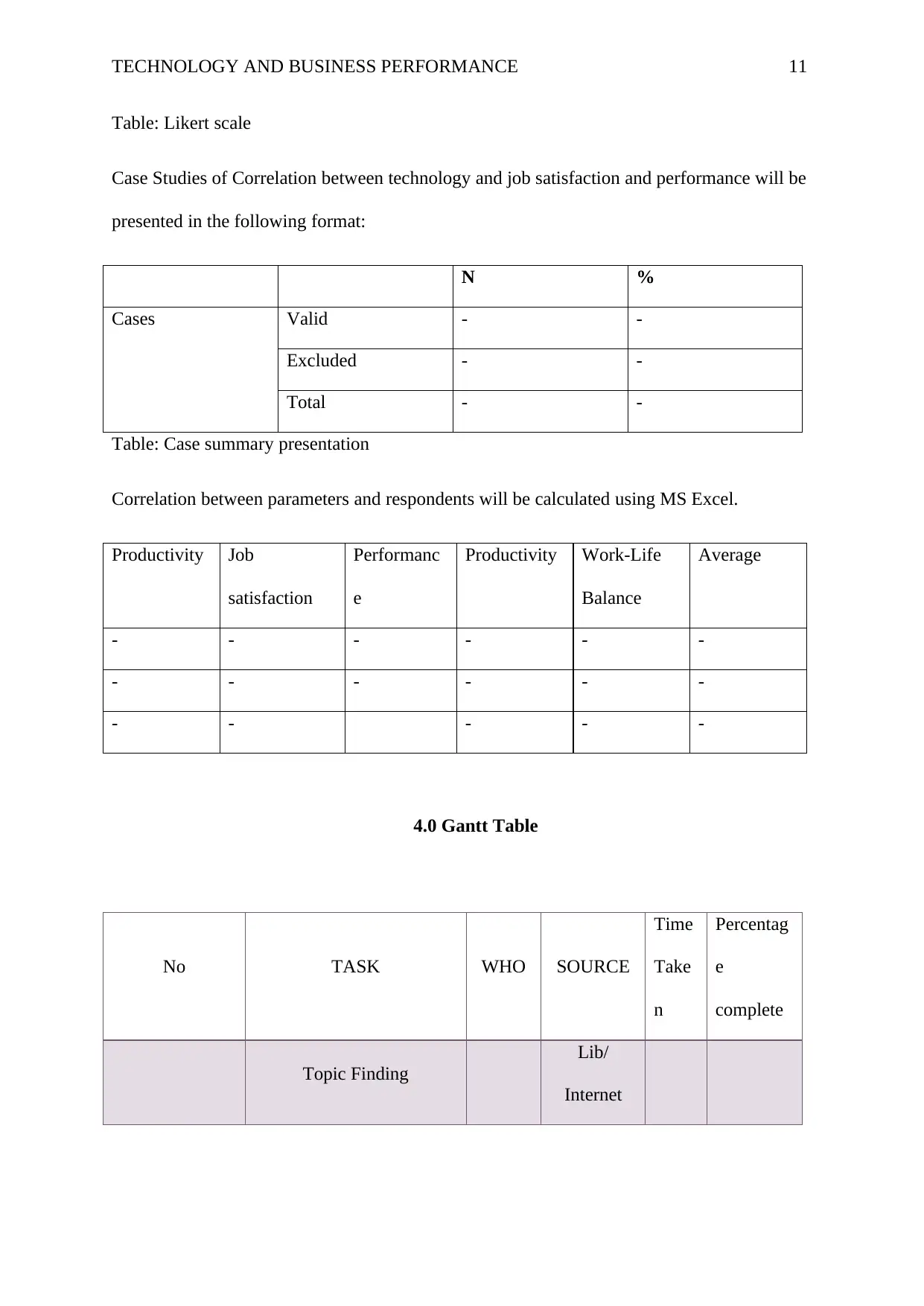
TECHNOLOGY AND BUSINESS PERFORMANCE 11
Table: Likert scale
Case Studies of Correlation between technology and job satisfaction and performance will be
presented in the following format:
N %
Cases Valid - -
Excluded - -
Total - -
Table: Case summary presentation
Correlation between parameters and respondents will be calculated using MS Excel.
Productivity Job
satisfaction
Performanc
e
Productivity Work-Life
Balance
Average
- - - - - -
- - - - - -
- - - - -
4.0 Gantt Table
No TASK WHO SOURCE
Time
Take
n
Percentag
e
complete
Topic Finding
Lib/
Internet
Table: Likert scale
Case Studies of Correlation between technology and job satisfaction and performance will be
presented in the following format:
N %
Cases Valid - -
Excluded - -
Total - -
Table: Case summary presentation
Correlation between parameters and respondents will be calculated using MS Excel.
Productivity Job
satisfaction
Performanc
e
Productivity Work-Life
Balance
Average
- - - - - -
- - - - - -
- - - - -
4.0 Gantt Table
No TASK WHO SOURCE
Time
Take
n
Percentag
e
complete
Topic Finding
Lib/
Internet
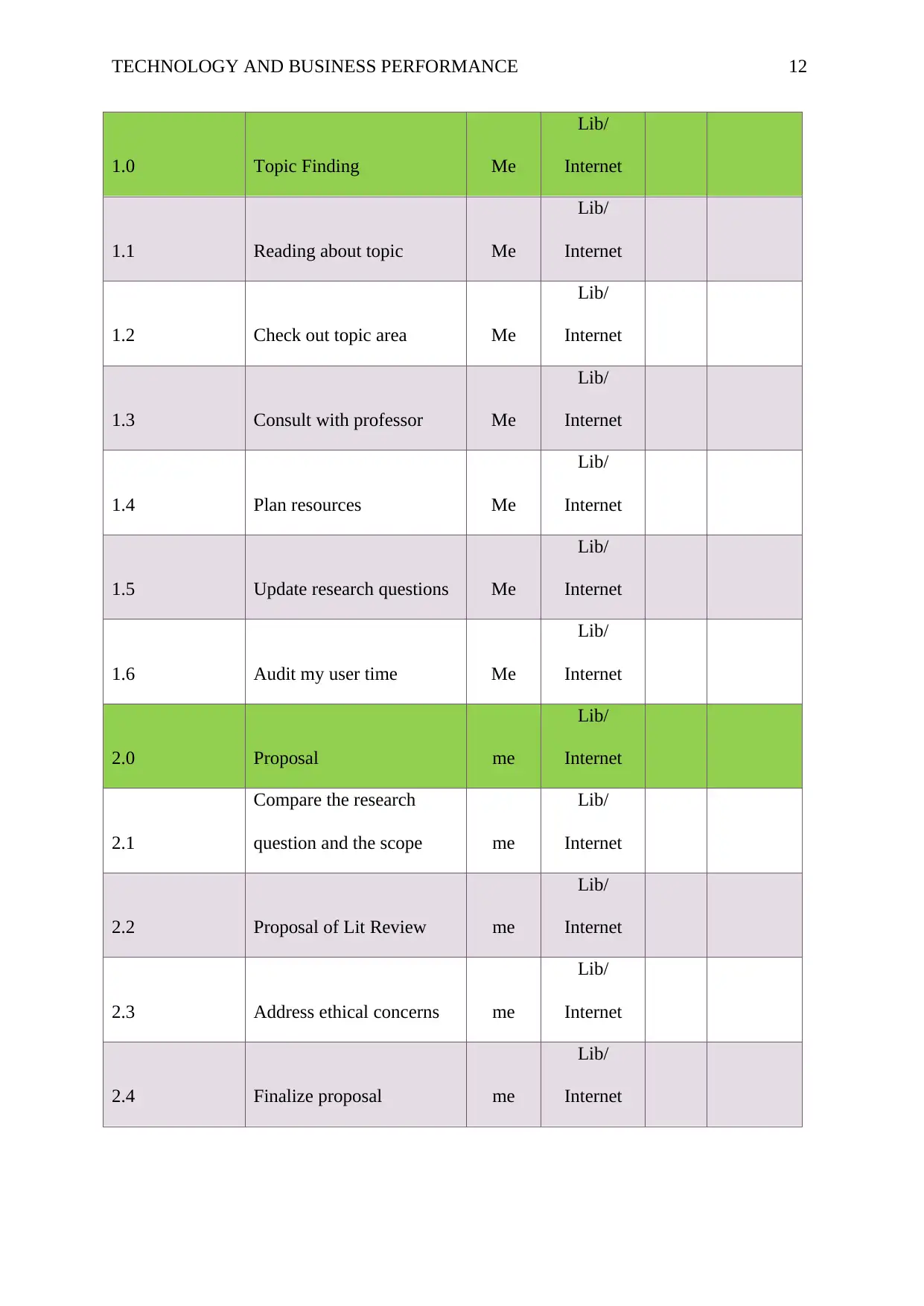
TECHNOLOGY AND BUSINESS PERFORMANCE 12
1.0 Topic Finding Me
Lib/
Internet
1.1 Reading about topic Me
Lib/
Internet
1.2 Check out topic area Me
Lib/
Internet
1.3 Consult with professor Me
Lib/
Internet
1.4 Plan resources Me
Lib/
Internet
1.5 Update research questions Me
Lib/
Internet
1.6 Audit my user time Me
Lib/
Internet
2.0 Proposal me
Lib/
Internet
2.1
Compare the research
question and the scope me
Lib/
Internet
2.2 Proposal of Lit Review me
Lib/
Internet
2.3 Address ethical concerns me
Lib/
Internet
2.4 Finalize proposal me
Lib/
Internet
1.0 Topic Finding Me
Lib/
Internet
1.1 Reading about topic Me
Lib/
Internet
1.2 Check out topic area Me
Lib/
Internet
1.3 Consult with professor Me
Lib/
Internet
1.4 Plan resources Me
Lib/
Internet
1.5 Update research questions Me
Lib/
Internet
1.6 Audit my user time Me
Lib/
Internet
2.0 Proposal me
Lib/
Internet
2.1
Compare the research
question and the scope me
Lib/
Internet
2.2 Proposal of Lit Review me
Lib/
Internet
2.3 Address ethical concerns me
Lib/
Internet
2.4 Finalize proposal me
Lib/
Internet
⊘ This is a preview!⊘
Do you want full access?
Subscribe today to unlock all pages.

Trusted by 1+ million students worldwide
1 out of 19
Related Documents
Your All-in-One AI-Powered Toolkit for Academic Success.
+13062052269
info@desklib.com
Available 24*7 on WhatsApp / Email
![[object Object]](/_next/static/media/star-bottom.7253800d.svg)
Unlock your academic potential
Copyright © 2020–2025 A2Z Services. All Rights Reserved. Developed and managed by ZUCOL.





